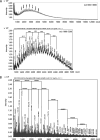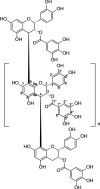Rapid Virucidal Activity of Japanese Saxifraga Species-Derived Condensed Tannins against SARS-CoV-2, Influenza A Virus, and Human Norovirus Surrogate Viruses
- PMID: 37184410
- PMCID: PMC10304655
- DOI: 10.1128/aem.00237-23
Rapid Virucidal Activity of Japanese Saxifraga Species-Derived Condensed Tannins against SARS-CoV-2, Influenza A Virus, and Human Norovirus Surrogate Viruses
Abstract
Severe acute respiratory syndrome coronavirus 2 (SARS-CoV-2), influenza A virus (IAV), and norovirus are global threats to human health. The application of effective virucidal agents, which contribute to the inactivation of viruses on hands and environmental surfaces, is important to facilitate robust virus infection control measures. Naturally derived virucidal disinfectants have attracted attention owing to their safety and eco-friendly properties. In this study, we showed that multiple Japanese Saxifraga species-derived fractions demonstrated rapid, potent virucidal activity against the SARS-CoV-2 ancestral strain and multiple variant strains, IAV, and two human norovirus surrogates: feline calicivirus (FCV) and murine norovirus (MNV). Condensed tannins were identified as active chemical constituents that play a central role in the virucidal activities of these fractions. At a concentration of 25 μg/mL, the purified condensed tannin fraction Sst-2R induced significant reductions in the viral titers of the SARS-CoV-2 ancestral strain, IAV, and FCV (reductions of ≥3.13, ≥3.00, and 2.50 log10 50% tissue culture infective doses [TCID50]/mL, respectively) within 10 s of reaction time. Furthermore, at a concentration of 100 μg/mL, Sst-2R induced a reduction of 1.75 log10 TCID50/mL in the viral titers of MNV within 1 min. Western blotting and transmission electron microscopy analyses revealed that Sst-2R produced structural abnormalities in viral structural proteins and envelopes, resulting in the destruction of viral particles. Furthermore, Saxifraga species-derived fraction-containing cream showed virucidal activity against multiple viruses within 10 min. Our findings indicate that Saxifraga species-derived fractions containing condensed tannins can be used as disinfectants against multiple viruses on hands and environmental surfaces. IMPORTANCE SARS-CoV-2, IAV, and norovirus are highly contagious pathogens. The use of naturally derived components as novel virucidal/antiviral agents is currently attracting attention. We showed that fractions from extracts of Saxifraga species, in the form of a solution as well as a cream, exerted potent, rapid virucidal activities against SARS-CoV-2, IAV, and surrogates of human norovirus. Condensed tannins were found to play a central role in this activity. The in vitro cytotoxicity of the purified condensed tannin fraction at a concentration that exhibited some extent of virucidal activity was lower than that of 70% ethanol or 2,000 ppm sodium hypochlorite solution, which are popular virucidal disinfectants. Our study suggests that Saxifraga species-derived fractions containing condensed tannins can be used on hands and environmental surfaces as safe virucidal agents against multiple viruses.
Keywords: SARS-CoV-2; Saxifraga; condensed tannin; influenza A virus; norovirus; virucidal activity.
Conflict of interest statement
The authors declare no conflict of interest.
Figures







Similar articles
-
Saxifraga spinulosa-Derived Components Rapidly Inactivate Multiple Viruses Including SARS-CoV-2.Viruses. 2020 Jun 28;12(7):699. doi: 10.3390/v12070699. Viruses. 2020. PMID: 32605306 Free PMC article.
-
Chemical constituents of five Saxifraga species and their virucidal activities.Fitoterapia. 2024 Dec;179:106215. doi: 10.1016/j.fitote.2024.106215. Epub 2024 Sep 14. Fitoterapia. 2024. PMID: 39278420
-
Virucidal Activities of Acidic Electrolyzed Water Solutions with Different pH Values against Multiple Strains of SARS-CoV-2.Appl Environ Microbiol. 2023 Jan 31;89(1):e0169922. doi: 10.1128/aem.01699-22. Epub 2022 Dec 13. Appl Environ Microbiol. 2023. PMID: 36511659 Free PMC article.
-
[Current topics on inactivation of norovirus].Kokuritsu Iyakuhin Shokuhin Eisei Kenkyusho Hokoku. 2011;(129):37-54. Kokuritsu Iyakuhin Shokuhin Eisei Kenkyusho Hokoku. 2011. PMID: 22259842 Review. Japanese.
-
Disinfectants against SARS-CoV-2: A Review.Viruses. 2022 Aug 4;14(8):1721. doi: 10.3390/v14081721. Viruses. 2022. PMID: 36016342 Free PMC article. Review.
Cited by
-
Effect of polyphenols against complications of COVID-19: current evidence and potential efficacy.Pharmacol Rep. 2024 Apr;76(2):307-327. doi: 10.1007/s43440-024-00585-6. Epub 2024 Mar 18. Pharmacol Rep. 2024. PMID: 38498260 Review.
-
Assessing the virucidal activity of essential oils against feline calicivirus, a non-enveloped virus used as surrogate of norovirus.Heliyon. 2024 Apr 29;10(9):e30492. doi: 10.1016/j.heliyon.2024.e30492. eCollection 2024 May 15. Heliyon. 2024. PMID: 38711631 Free PMC article.
-
An Abies Extract Containing Nonvolatile Polyphenols Shows Virucidal Activity against SARS-CoV-2 That Is Enhanced in Increased pH Conditions.Pathogens. 2023 Aug 28;12(9):1093. doi: 10.3390/pathogens12091093. Pathogens. 2023. PMID: 37764901 Free PMC article.
-
The First Records of the In Silico Antiviral and Antibacterial Actions of Molecules Detected in Extracts of Algerian Fir (Abies numidica De Lannoy) Using LC-MS/MS Analysis.Plants (Basel). 2024 Apr 30;13(9):1246. doi: 10.3390/plants13091246. Plants (Basel). 2024. PMID: 38732461 Free PMC article.
References
-
- Carabelli AM, Peacock TP, Thorne LG, Harvey WT, Hughes J, de Silva TI, Peacock SJ, Barclay WS, de Silva TI, Towers GJ, Robertson DL. COVID-19 Genomics UK Consortium. 2023. SARS-CoV-2 variant biology: immune escape, transmission and fitness. Nat Rev Microbiol doi:10.1038/s41579-022-00841-7. - DOI - PMC - PubMed
Publication types
MeSH terms
Substances
LinkOut - more resources
Full Text Sources
Medical
Research Materials
Miscellaneous

